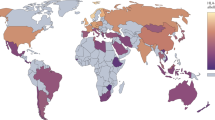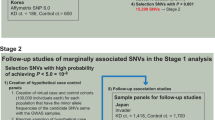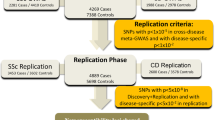Abstract
Intercellular adhesion molecule-1 (ICAM-1) and its receptors are adhesion molecules that play a key role in the transmigration of inflammatory cells through the blood–brain barrier, one of the earliest events in multiple sclerosis (MS), which leads to demyelination in the central nervous system. To investigate the role of genes encoding ICAM-1 and its receptors, we used a strategy of genetic linkage and association in 439 case–parent MS families of French origin, well characterized according to HLA status and severity. We demonstrate that the genes encoding ICAM-1 receptors do not influence MS susceptibility or severity. ICAM-1 had a modest, but significant effect on MS genetic susceptibility, independent of HLA and disease severity. We observed a rare, and an as yet unreported, ICAM-1 gene haplotype defined by amino acids K469 and R241 that was never transmitted to patients suggesting a protective effect against MS in our population.
This is a preview of subscription content, access via your institution
Access options
Subscribe to this journal
Receive 6 digital issues and online access to articles
$119.00 per year
only $19.83 per issue
Buy this article
- Purchase on Springer Link
- Instant access to full article PDF
Prices may be subject to local taxes which are calculated during checkout

Similar content being viewed by others
References
Alperovitch A . Epidemiologie de la sclèrose en plaques. Med Therap 1995; 1: 545–548.
Poser CM . The epidemiology of multiple sclerosis: a general overview. Ann Neurol 1994; 36: 180–193.
Cannella B, Cross AH, Raine CS . Upregulation and coexpression of adhesion molecules correlate with relapsing autoimmune demyelination in the central nervous system. J Exp Med 1990; 172: 1521–1524.
Springer TA . Adhesion receptors of the immune system. Nature 1990; 346: 425–434.
Raine CS, Cannella B . Adhesion molecules and central nervous system inflammation. Semin Neurosci 1992; 4: 201–219.
Osborn L . Leukocyte adhesion to endothelium in inflammation. Cell 1990; 62: 3–6.
Springer TA . Traffic signals for lymphocyte recirculation and leukocyte emigration: the multistep paradigm. Cell 1994; 76: 301–314.
Pryce G, Male D, Campbell I, Greenwood J . Factors controlling T-cell migration across rat cerebral endothelium in vitro. J Neuroimmunol 1997; 75: 84–94.
Male D, Rahman J, Pryce G, Tamatani T, Miyasaka M . Lymphocyte migration into the CNS modelled in vitro: roles of LFA-1, ICAM-1 and VLA-4. Immunology 1994; 81: 366–372.
Greenwood J, Wang Y, Calder VL . Lymphocyte adhesion and transendothelial migration in the central nervous system: the role of LFA-1, ICAM-1, VLA-4 and VCAM-1. off. Immunology 1995; 86: 408–415.
Marlin SD, Springer TA . Purified intercellular adhesion molecule-1 (ICAM-1) is a ligand for lymphocyte function-associated antigen 1 (LFA-1). Cell 1987; 51: 813–819.
Diamond MS, Staunton DE, Marlin SD, Springer TA . Binding of the integrin Mac-1 (CD11b/CD18) to the third immunoglobulin-like domain of ICAM-1 (CD54) and its regulation by glycosylation. Cell 1991; 65: 961–971.
Smith CW, Marlin SD, Rothlein R, Toman C, Anderson DC . Cooperative interactions of LFA-1 and Mac-1 with intercellular adhesion molecule-1 in facilitating adherence and transendothelial migration of human neutrophils in vitro. J Clin Invest 1989; 83: 2008–2017.
Neelamegham S, Taylor AD, Burns AR, Smith CW, Simon SI . Hydrodynamic shear shows distinct roles for LFA-1 and Mac-1 in neutrophil adhesion to intercellular adhesion molecule-1. Blood 1998; 92: 1626–1638.
Greve JM, Davis G, Meyer AM et al. The major human rhinovirus receptor is ICAM-1. Cell 1989; 56: 839–847.
Olson NH, Kolatkar PR, Oliveira MA et al. Structure of a human rhinovirus complexed with its receptor molecule. Proc Natl Acad Sci 1993; 90: 507–511.
Mycko MP, Kwinkowski M, Tronczynska E, Szymanska B, Selmaj KW . Multiple sclerosis: the increased frequency of the ICAM-1 exon 6 gene point mutation genetic type K469. Ann Neurol 1998; 44: 70–75.
Luomala M, Elovaara I, Koivula T, Lehtimaki T . Intercellular adhesion molecule-1 K/E 469 polymorphism and multiple sclerosis. Ann Neurol 1999; 45: 546–547.
Marrosu MG, Schirru L, Fadda E et al. ICAM-1 gene is not associated with multiple sclerosis in sardinian patients. J Neurol 2000; 247: 677–680.
Killestein J, Schrijver HM, Crusius JB et al. Intracellular adhesion molecule-1 polymorphisms and genetic susceptibility to multiple sclerosis: additional data and meta-analysis. Ann Neurol 2000; 47: 277–279.
Spielman RS, McGinnis RE, Ewens WJ . Transmission test for linkage disequilibrium: the insulin gene region and insulin-dependent diabetes mellitus (IDDM). Am J Hum Genet 1993; 52: 506–516.
Akey J, Jin L, Xiong M . Haplotypes vs single marker linkage disequilibrium tests: what do we gain? Eur J Hum Genet 2001; 9: 291–300.
Douglas JA, Boehnke M, Gillanders E, Trent JM, Gruber SB . Experimentally-derived haplotypes substantially increase the efficiency of linkage disequilibrium studies. Nat Genet 2001; 28: 361–364.
Fallin D, Cohen A, Essioux L et al. Genetic analysis of case/control data using estimated haplotype frequencies: application to APOE locus variation and Alzheimer's disease. Genome Res 2001; 11: 143–151.
Zaykin DV, Westfall PH, Young SS et al. Testing association of statistically inferred haplotypes with discrete and continuous traits in samples of unrelated individuals. Hum Hered 2002; 53: 79–91.
Risch N . The future of genetic studies of complex human diseases. Science 1996; 273: 1516–1517.
Poser CM, Paty DW, Scheinberg L et al. New diagnostic criteria for multiple sclerosis: guidelines for research protocols. Ann Neurol 1983; 13: 227–231.
Goodkin DE, Doolittle TH, Hauser SS et al. Diagnostic criteria for multiple sclerosis research involving multiply affected families. Arch Neurol 1991; 48: 805–807.
Mertens C, Brassat D, Reboul J et al. A systematic study of oligodendrocyte growth factors as candidates for genetic susceptibility to MS. French Multiple Sclerosis Genetics Group. Neurology 1998; 51: 748–753.
Reboul J, Mertens C, Levillayer F et al. Cytokines in genetic susceptibility to multiple sclerosis: a candidate gene approach. French Multiple Sclerosis Genetics Group. J Neuroimmunol 2000; 102: 107–112.
Kurtzke JF . Rating neurologic impairment in multiple sclerosis: an expanded disability status scale (EDSS). Neurology 1983; 33: 1444–1452.
Brassat D, Azais-Vuillemin C, Yaouanq J et al. Familial factors influence disability in MS multiplex families. French Multiple Sclerosis Genetics Group. Neurology 1999; 52: 1632–1636.
Yaouanq J, Semana G, Eichenbaum S et al. Evidence for linkage disequilibrium between HLA-DRB1 gene and multiple sclerosis. The French Research Group on Genetic Susceptibility to MS. Science 1997; 276: 664–665.
Sawcer S, Jones HB, Feakes R et al. A genome screen in multiple sclerosis reveals susceptibility loci on chromosome 6p21 and 17q22. Nat Genet 1996; 13: 464–468.
The Multiple Sclerosis Genetics Group, Haines JL, Ter-Minassian M et al. A complete genomic screen for multiple sclerosis underscores a role for the major histocompatability complex. The Multiple Sclerosis Genetics Group. Nat Genet 1996; 13: 469–471.
Staunton DE, Dustin ML, Erickson HP, Springer TA . The arrangement of the immunoglobulin-like domains of ICAM-1 and the binding sites for LFA-1 and rhinovirus. Cell 1990; 61: 243–254.
Staunton DE, Merluzzi VJ, Rothlein R et al. A cell adhesion molecule, ICAM-1, is the major surface receptor for rhinoviruses. Cell 1989; 56: 849–853.
Hoover-Litty H, Greve JM . Formation of rhinovirus-soluble ICAM-1 complexes and conformational changes in the virion. J Virol 1993; 67: 390–397.
Rossmann MG . Viral cell recognition and entry. Protein Sci 1994; 3: 1712–1725.
Ockenhouse CF, Tegoshi T, Maeno Y et al. Human vascular endothelial cell adhesion receptors for Plasmodium falciparum-infected erythrocytes: roles for endothelial leukocyte adhesion molecule 1 and vascular cell adhesion molecule 1. J Exp Med 1992; 176: 1183–1189.
Thomson G . Mapping disease genes: family-based association studies. Am J Hum Genet 1995; 57: 487–498.
Acknowledgements
We thank patients, their families and physicians for their help and support. The French Multiple Sclerosis Genetics Group, Genethon, the CIC Pitié-Salpêtrière, INSERM and the French Ministry of Research (CRB) provided help for the DNA bank. This work was supported by ARSEP, INSERM and FRM (Action 2000).
Author information
Authors and Affiliations
Corresponding author
Rights and permissions
About this article
Cite this article
Cournu-Rebeix, I., Génin, E., Lesca, G. et al. Intercellular adhesion molecule-1: a protective haplotype against multiple sclerosis. Genes Immun 4, 518–523 (2003). https://doi.org/10.1038/sj.gene.6364009
Published:
Issue Date:
DOI: https://doi.org/10.1038/sj.gene.6364009
Keywords
This article is cited by
-
Analysis of ICAM1 gene polymorphism in Slovak multiple sclerosis patients
Folia Microbiologica (2017)
-
ICAM1 K469E and E-selectin S128R polymorphisms could predispose to increased autoantibody production and TSH suppression in Graves’ disease
Molecular Biology Reports (2013)
-
ICAM1 amino-acid variant K469E is associated with paediatric bronchial asthma and elevated sICAM1 levels
Genes & Immunity (2006)



